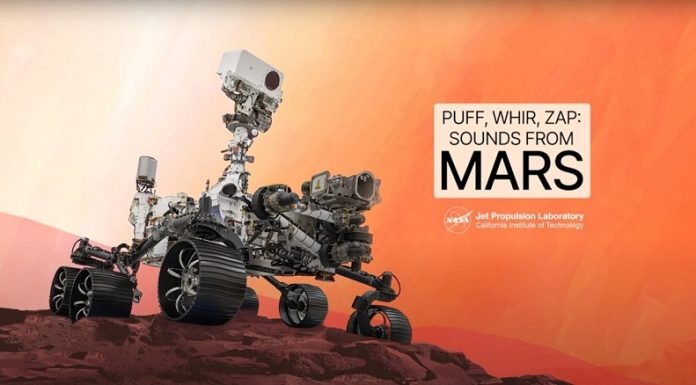
If you want to hear what Mars has to say, you’re going to have to listen closely. Very closely.
It’s not that there isn’t any sound on Mars.
Of course there is.
Martian ambiance – recorded on microphones attached to NASA’s Perseverance rover – is largely dominated by the gentle clipping of the mic as the wind sweeps across the landscape.
The soundscape of Jezero crater, where the rover made its landing last February, is further punctuated by the mechanical groans of Perseverance itself, the crackle of its ‘SuperCam’ laser instrument, and exhales of gas as the rover blows dust away from outcrops of rock for closer study.
Perseverance even recorded the whirring rotors of its small companion robot, Ingenuity, a tiny helicopter being used to scout terrain ahead of the rover’s path.
But even with all this activity, Mars is unsettlingly quiet.
“At some point, we thought the microphone was broken, it was so quiet,” says Sylvestre Maurice, an astrophysicist at the University of Toulouse who is studying the behavior of soundwaves in Mars’ atmosphere.
Maurice and his colleagues have been closely examining the recordings sent back to Earth over the past year by Perseverance, and they say the culprit responsible for the spell of silence cast upon the Red Planet is the thin atmosphere itself.
Composed largely of CO2, the gas blanketing Mars is about one percent as dense as Earth’s atmosphere, and at these low pressures, sound transmits sound far more slowly.
The speed of sound is not a universal constant. It changes depending on the medium through which the sound is passing.
On Earth, sound travels around 767 mph, or 343 meters per second, but on Mars, “low-pitched sounds travel at about 537 mph (240 meters per second), while higher-pitched sounds move at 559 mph (250 meters per second).“
Not only does sound move more slowly on Mars, but it doesn’t travel as far either, dissipating extraordinarily quickly. A sound that travels 65 meters on Earth might only go 8 meters on Mars, and a high-pitched sound wouldn’t even make it that far. The result is an eerie, muffled environment.
Scientists have created models that predict how sound might act in a Mars-like environment, but these recordings are the first chance they’ve had to test their models. Previous attempts to land a microphone on Mars were fraught with trouble.
The 1999 Polar Lander spacecraft carried one, but crashed into the surface before taking any data. NASA’s Pheonix Lander had one too, but it suffered technical difficulties before launch and the mic was never used. A French mission called Netlander intended to carry one, but got canceled in 2004. It was only in 2021 that Martian sounds were finally recorded.
The success of Perseverance’s microphones has at last opened up new opportunities for studying the Martian atmosphere via soundwaves.
Researchers have been able to use sound to measure pressure changes caused by turbulence in the atmosphere, and also by the seasons.
As Martian summer approaches, researchers expect pressures to rise, and so Mars will get ‘noisier.’ According to Baptiste Chide, another researcher studying these recordings, “We are entering a high-pressure season. Maybe the acoustic environment on Mars will be less quiet than it was when we landed.”
Alongside their scientific value, Perseverance’s microphones have practical engineering uses too, allowing the rover’s team to monitor and diagnose the rover’s performance.
Like listening to a car’s engine for funny sounds or unexpected squeaks, engineers can use the recordings to catch anomalies in the rover’s mechanicals. As the rover ages, and is subjected to more wear and tear, this new diagnostic tool may prove extremely valuable.
Written by Scott Alan Johnston.
Source: Universe Today.



